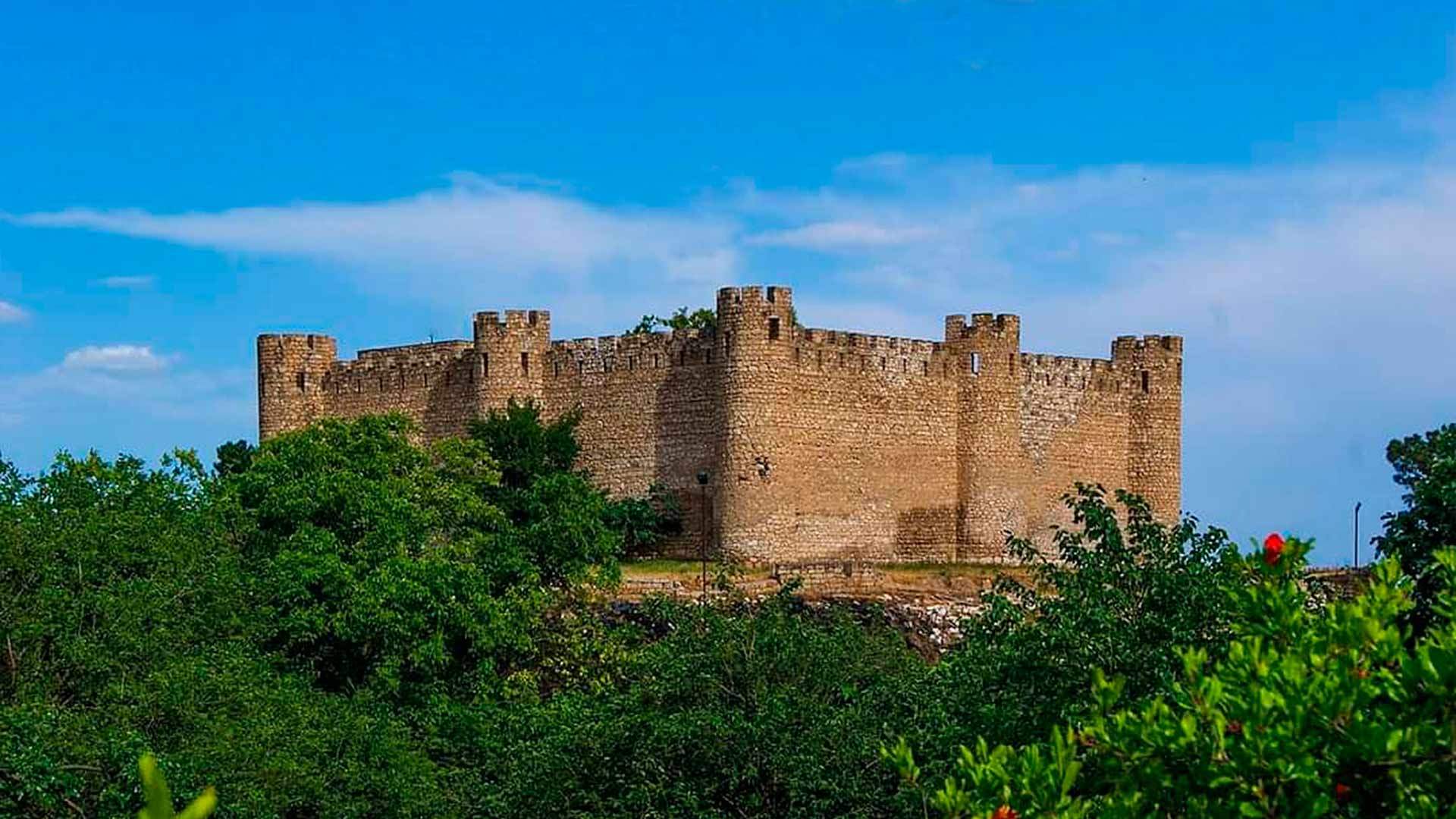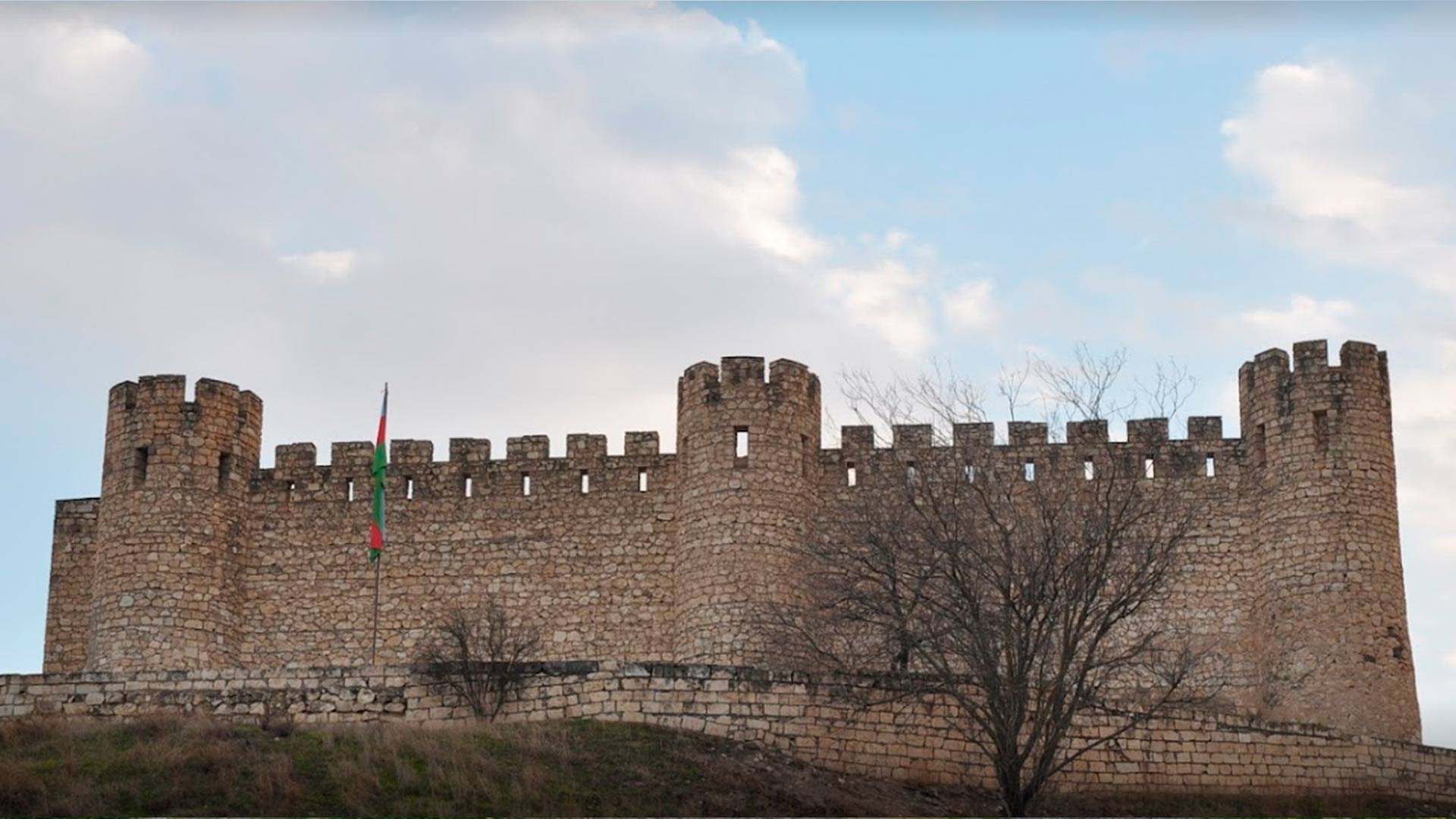The symbol of the rising power of the Karabakh’s ruler Panah Ali Khan: Shahbulag Fortress
After the occupation of the city of Aghdam by the Armenian armed formations, on July 23, 1993, the Shahbulag fortress was subjected to vandalism. With the liberation of Aghdam from the Armenian occupation, on November 20, 2020, the fortress was restored. Shahbulag Fortress is the second administrative center of the Karabakh Khanate located about 10 km from the city of Aghdam.
 The Shahbulag fortress is located at the foot of a hill near the village of Shahbulag in the Aghdam district of Azerbaijan.
The Shahbulag fortress is located at the foot of a hill near the village of Shahbulag in the Aghdam district of Azerbaijan.
The fortress was built by Panakh Ali khan of Karabakh in 1751-1752 (1748-1749). However, according to the legend, the Shahbulag fortress was built by Nader Shah Afshar during his conquest of Karabakh.
[Mirza-Adigezal-bey. Karabakh-name 1950, p. 55]
[Mirza Jamal Javanshir Karabaghi. The History of Karabakh. 1959, p. 70;101]
[Ch.Gajar. Old Shusha. 2007, p. 69]
[Newspaper “Kavkaz” (Caucasus) № 62.1852, p. 260]
[E. Weidenbaum. Guide to the Caucasus. 1888, p. 394]
Having won a victory over the Sheki and Shirvan khans in the battle near the Bayat fortress in 1748, Panah Ali Khan, in order to effectively fight with the Karabakh meliks, decided to build a more protected fortress in the village of Tarnakut near the Shahbulag spring which received its name from the Safavid ruler Shah Abbas I.
Azerbaijani historian Mirza Adigezal-bey noted:
“After this event, Panah-Khan thought: only recently I stood on my own feet, the population of Javanshir, the Otuziki are against me, the meliks of Khamse feud with me. I have to settle down in a more fortified and impregnable place. I should not be indifferent to the scheming and encroachments of the enemies”
[Mirza-Adigezal-bey. Karabagh-name 1950, p. 54 – 55]
[Mirza Jamal Javanshir Karabaghi. The History of Karabakh. 1959, p. 68]
[Abbasqulu-aga Bakikhanov. Gulistan-i Iram.1991, p. 77]
The Russian military historian V. Potto described the fortress as follows:
“In the Karabakh Khanate, at the foot of a rocky hill, near the road from Elizavetpol to Shusha, there is an ancient castle surrounded by a high stone wall with six dilapidated round towers. Near this castle, which amazes a traveler with its grandiose massive contours, the Shah-Bulakh spring spurts.”
[V.Potto. The Caucasian War in distinct essays, episodes, legends and biographies. Volume 2.1887 p. 378]
The book “Strengthening of Russian Rule in the Caucasus” of 1901 provides a detailed description of the fortress:
“Shahbulag castle is located on the bank of the river of the same name. It was built by one of the rulers of Karabakh, Panah Khan, in order to be a winter residence when cold and blizzards dominate on top of the Shusha rocks. The remains of the castle, relatively little affected by time, are still visible on the top of the hill, next to the high-water springs that gave its name to the erection. Behind its high walls, a detachment could hold out until the arrival of the help, if only there was enough food. By means of field-guns one cannot breach the thick walls of the Shahbulag castle”.
[Strengthening of Russian rule in the Caucasus. Volume I. 1901, pp. 208-209]
In the book “Architecture of the city of Shusha and the problems of preserving its historical appearance” in 1977, the following is written about the fortress:
“The castle of Panah Khan in the plan is a small rectangular structure surrounded from all sides by defensive walls, fortified at all the outer four corners by round three-quarter combat towers. In addition, semicircular towers adjoin the center of each wall, except for the eastern one. There were two citadels in the fortress – one inside and the second outside the fortress, which has not survived to this day.The outer walls and towers of the castle were somewhat thin and ended with battlements.
The height of the walls is up to 7 m, and the towers are up to 8.5 m. The walls and towers of the castle along their entire length were cut through by narrow embrasures, below which, at a level convenient for conducting defense from embrasures, were the roofs of one-story premises. Probably, they once adjoined the walls of the castle along the entire inner perimeter, forming an inner courtyard. Now only two corner premises have been preserved, covered with stone arches and adjacent to the western wall of the castle. The traces of niches have been preserved in these premises.
The entrance to the castle was located in the center of the eastern wall and was surrounded by a high two-story prismatic construction adjacent to it, from the southern end of which an L- shaped entrance was placed. The entrance arches located at right angles to each other did not give direct access to the castle. This prismatic construction was the eighth, the main tower over the gate, which towered over the entire Shahbulag castle. It can be assumed that the upper floor of the tower over the gate was occupied by Panakh Khan himself. A stone staircase led to the second floor of the tower over the gate from the courtyard. At present, the upper floor of the tower has not been preserved”.
[ E.Avalov. The architecture of the city of Shusha and the problems of preserving its historical appearance. 1977, p. 10 – 13]

After the construction of the fortress was completed, Panah Ali Khan settled in it with his family in 1750. Out of stone and limestone, he built a mosque, a bazaar, a bathhouse and a square in the fortress. As Azerbaijani historian Mirza Jamal Karabagi notes:
“After a lapse of three or four years of independent [rule] in Shahbulagi, the rumor about the independence, ever-increasing power of [Panakh Khan] and the number of his supporters became widely known in the surrounding areas”.
[Mirza Jamal Javanshir Karabaghi. The History of Karabakh. 1959, p. 70]
Due to the inconvenient strategic location of the fortress on the lowlands and the sultry climate of the area, Panah Ali Khan decided to leave the fortress, on the eve of the threat of attack from the ruler of Iran, Muhammad Hasan Khan Gajar and neighboring khans.
Mirza Jamal Karabagi writes the following:
“It is not inconceivable that they (neighboring khans) will instigate Muhammad Hassan Khan and together with him will start a war with us. Then the ilats and the troops of Karabakh will be defeated by the Kyzylbash troops and we all, not being able to resist in the Shahbulagi fortress before such a powerful enemy and the troops of neighboring khans, will perish. Therefore, it is necessary to prevent the event without waiting for it to occur””
[Akhmed Bey Javanshir. On the political existence of the Karabakh Khanate (from 1747 to 1805), 1961, p. 72]
[Mirza Jamal Javanshir Karabaghi. The History of Karabakh. 1959, p. 72]
After Panah Ali Khan moved his residence to Shusha, the Shahbulag fortress gradually fell into a state of disrepair.
[Azerbaijan. (Historical and noteworthy places). 1960, p. 134]
[Azerbaijani Soviet Encyclopedia – X vol. 1987, p. 476]
During the Russian-Iranian War (1804-1813), the Shahbulag fortress was in the center of hostilities three times (in 1805,1810 and 1812) and passed from hand to hand.
[Strengthening of Russian rule in the Caucasus. Volume I. 1901, pp. 208-212]
[Strengthening of Russian rule in the Caucasus. Volume II. 1902, pp. 189-190]
[V.Potto. The Caucasian War in distinct essays, episodes, legends and biographies. Volume 1.1887, pp. 480-481]
In the book “Yevlakh-Shusha: An Archaeological Essay” of 1928, it is noted that only ruins remained from the fortress.
[Yevlakh-Shusha: An archaeological essay. J.Alexandrovich, I.Azimbekov, M.Sysoev. 1928., p. 8]
With the occupation of the Aghdam district by the Armenian armed formations, in 1993, the fortress was subjected to vandalism.